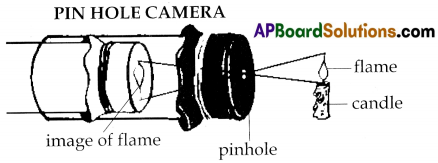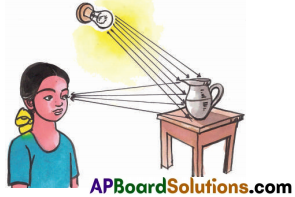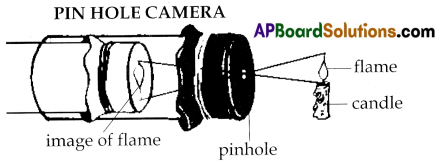These TS 6th Class Science Important Questions 15th Lesson Light, Shadows and Images will help the students to improve their time and approach.
TS 6th Class Science Important Questions 15th Lesson Light, Shadows and Images
Question 1.
Why am I (are we) not able to see the objects clearly when it gets dark?
(or)
Why am I (are we) not able to see the objects when power went off?
Answer:
We see the objects only when the light falls on them and bounces back.
That is why we can’t see the object clearly when it gets dark.
![]()
Question 2.
How are we able to see the objects in the presence of light?
Answer:
When light falls on the object it gets reflected on our eyes. Therefore the reflection of light from the exposed object makes us to see it clearly.
Question 3.
Where does light come from?
Answer:
Light comes from objects that are called sources of light.
Eg: Sun, candle, stars, moon, fire, oil lamps, bulbs etc.
Question 4.
Is moon a source of light? Can you give some more examples for source of light?
Answer:
Moon is a source of light. Other sources of light are candle, the sun, oil lamps, fire, tube lights, bulbs etc…
![]()
Question 5.
Define source of light? Give example.
Answer:
A substance which gives light is known as a light source.
Eg : Sun, glowing bulb, candle etc.
Question 6.
How can we see an object?
Answer:
We can see an object only when light falls on it, bounces back and reaches our eye.
Question 7.
Which objects give us light?
Answer:
Sun, stars, a glowing bulb, lightened candle, kerosene lamp etc. give light.
They are known as ‘sources of light’.
Question 8.
When did you see your shadow ? Is it during day time or at night?
Answer:
I saw my shadow during the day time.
![]()
Question 9.
What do we need to form a shadow?
Answer:
We need light source to get the shadow of any object.
Question 10.
What is shadow puppetry ?
Answer:
- Shadow puppetry is one of our traditional recreational activities.
- In this, some puppets are used to form shadows on a screen and a story is narrated with the help of these shadows.
Question 11.
Why do we get an ‘inverted image’ in a pinhole camera?
Answer:
Reason of inversion of image:
Light from the candle travels straight in all directions from each point of the flame of the candle.
But only the light coming in some particular directions can enter into the camera through its pinhole.
Light which comes from the point at the top of the flame goes straight towards the bottom of the screen.
Light which comes from the point at the bottom of the flame goes straight towards the top of the screen.

In this way, the light coming in a particular direction from each point of the flame will be able to enter into the pinhole. Light going in other directions is filled out due to the pinhole.This leads to the formation of an inverted image.
![]()
Question 12.
What difference do you notice between the images formed through the pin-hole camera and through a magnifying glass?
Answer:
The image formed through the magnifying lens is clearer than that formed with a pinhole camera.
Question 13.
What is ‘reflection’?
Answer:
When light falls on any object, it rehounces back. This is called reflection.
Question 14.
Can you see the light reflected by an object?
Answer:
We can see the reflected light only when light falls on the objects like mirror.
Question 15.
How does mirror differ from a glass sheet?
Answer:
A mirror reflects light falling on it. A glass sheet transmits the light falling on it.
Question 16.
Predict what would happen if we make two pinholes in the camera.
Answer:
Two inverted images form. They overlap each other. They are not so clear.
![]()
Question 17.
What is the object that emits light of its own, called?
Answer:
Luminous object.
Question 18.
What do you call, a brilliantly polished reflecting surface?
Answer:
A mirror.
Question 19.
What is the dark patch of an object cast on the screen, called?
Answer:
Its shadow.
Question 20.
What is throwing back of light rays by a surface called?
Answer:
Reflection.
Question 21.
To which class these belong?
a. a piece of red hot iron
b. sun
c. firefly
Answer:
Luminous objects.
![]()
Question 22.
What type image forms in a pinhole camera?
Answer:
An inverted image.
Question 23.
Why are the shapes of the shadows of the same object different when you change the position of the object?
Answer:
The shapes of the shadows are guessed only when we consider that light travel as rays along a straight path.
Question 24.
Read the following paragraph and frame at/east two questions.
We know that shadows are not coloured but an ¡mage has colours that are same as
that of the object. Also, a shadow shows only the outline of the object but an image
shows the complete object as it is, just like a photograph.
Answer:
- What is the difference between a shadow and an image?
- How can we make shadows?
- How can we make an image?
![]()
Question 25.
Can you guess the object by observing its shadow ?
Answer:
It is not always possible to guess the object by observing its shadow.
Question 26.
Is it possible to guess the colour of the object by observing its shadow?
Answer:
No. Shadow is always colourless irrespective of the colour of the object.
Question 27.
Can you guess the shape of the shadow that would be formed by an object?
Answer:
Yes. We can get different shaped shadows for a single object by changing its position.
Question 28.
Write the required apparatus or material for making pinhole camera.
Answer:
Requirements:
- A PVC pipe of about 8cm in diameter and 30cm in length.
- Another PVC pipe of about 7cm in diameter and 20cm in length.
- One black drawing sheet.
- Oil – 1ml.
- Two rubber bands
- A pin and
- A4 sheet.
Question 29.
You are provided with a book, a pen, a duster, a polythene cover and a glass plate. Answer the following questions.
i. Which objects form shadows ? Why?
Answer:
a. Book, pen and duster form clear shadows.
Reason: They are opaque objects.
b. Polythene cover forms an unclear shadow.
Reason: It is a translucent substance.
ii. Which objects do not form shadows?
Answer: Glass
Reason : Glass (also air) is a transparent substance.
![]()
Question 30.
How can you make a pinhole camera?
Answer:
Making a pinhole camera.
Requirements:
- A PVC pipe of about 8 cm in diameter and 30 cm in length.
- Another PVC pipe of about 7 cm in diameter and 20 cm in length.
- One black drawing sheet.
- Oil -1 ml
- Two rubber bands
- A pin and
- A 4 sheet
Method:
- A piece of black paper is cut and put like a cap at one end of the big PVC pipe. It is fixed with a rubber band.
- The white paper is put like a cap at one end of the thinner PVC pipe. It is also fixed with a rubber band.
- A hole is made in the middle of black paper cap with the pin.
- 2 to 3 drops of oil is put on the white paper cap so that it becomes translucent.
- The thin pipe is slide into the big pipe. Now the pinhole camera is ready.
Question 31.
See the picture given below.
Answer the following questions:
i. Is the object visible to her even after holding the plank infront of the girl face, there is light?
ii. What happens when you hold a plank between the object and girl?

Answer:
i. The object is not visible, though there is light.
ii. The plank that is held between girl and object obstructs the reflection of light that bounces back from it.
Question 32.
Read the para and answer the questions.
The objects which form shadow are called opaque substances.
Eg: stone, book, stick etc.
The substances which allow light to pass through them are called transparent substances. Eg: glass
i. Give the examples of opaque substances.
ii. If a student playing with polythene cover, does he see shadow through that ? Why?
iii. What are transparent substances?
iv. If light falls on book how does the shadow appear?
Answer:
i. Stone, hook, stick etc.
ii. He doesn’t see the shadow. Because polythene cover is a transparent substance.
iii. The substances which allow light to pass through them are transparent substances.
iv. If light falls on one side of the book the shadow appears on other side.
![]()
Question 33.
Draw the diagram of pinhole camera.
Answer:

Question 34.
Observe the figures given below.
Write whether the sheet held by the boy is transparent, translucent or opaque below each of the pictures.

Answer:
- Sheet 1 is opaque
- Sheet 2 is transparent
- Sheet 3 is translucent
Question 35.
Based on the above given pictures A, B, C guess the types of objects regarding shadow formation. Classify and name them according to light passing through them.

Answer:
The given pictures show the types of objects which allow the light to form shades. As per the observations the pictures of objects are classified âS these substances.
A. Opaque substances: The form shades when light falls on them.
B. Transparent substances: They allow light to pass through them.
C. Translucent substances: They form unclear shadows.
![]()
Question 36.
How do you feel when you see object that form different shapes of shades?
Answer:
We must have wondered when we compared our guesses and the actual objects of which shadows are formed.
Eg : We may notice that the shadows that look like bird and animals are actually formed by hands.